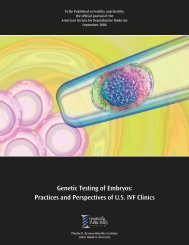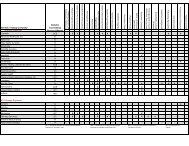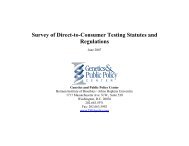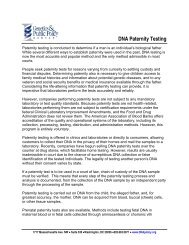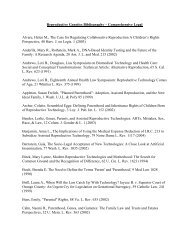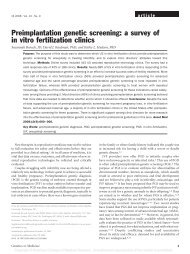Preimplantation Genetic Diagnosis - Genetics & Public Policy Center
Preimplantation Genetic Diagnosis - Genetics & Public Policy Center
Preimplantation Genetic Diagnosis - Genetics & Public Policy Center
Create successful ePaper yourself
Turn your PDF publications into a flip-book with our unique Google optimized e-Paper software.
have authority to sanction members for noncompliance.<br />
Unless the organization is specifically authorized by the federal<br />
government to act on the government’s behalf in<br />
administering and enforcing government standards, actions of<br />
the professional organization do not have the force of law.<br />
For PGD, a few different professional organizations have<br />
relevant expertise and either currently possess or could in the<br />
future develop PGD-specific guidelines or standards. For<br />
example, the American Society for Reproductive Medicine<br />
(ASRM) is a professional organization whose members are<br />
health professionals engaged in reproductive medicine. ASRM<br />
issues policy statements, guidelines and opinions regarding a<br />
variety of medical and ethical issues that reflect the thinking of<br />
the organization’s various practice committees. These<br />
documents, while not binding on members, may be viewed as<br />
evidence of standards of practice in legal settings.<br />
In 2001 ASRM issued a practice committee opinion<br />
addressing PGD stating that PGD “appears to be a viable<br />
alternative to post-conception diagnosis and pregnancy<br />
termination.” It further states that while it is important for<br />
patients be aware of “potential diagnostic errors and the<br />
possibility of currently unknown long-term consequences on<br />
the fetus” from the biopsy procedure, “PGD should be<br />
regarded as an established technique with specific and<br />
expanding applications for standard clinical practice.” ASRM<br />
has also issued an ethics committee opinion cautioning against<br />
the use of PGD for sex selection in the absence of a serious<br />
sex-linked disease.<br />
to organize meetings and workshops on PGD research.<br />
PGDIS may take on additional functions in the future.<br />
An international organization, the European Society for<br />
Human Reproduction and Embryology (ESHRE), tracks<br />
PGD outcomes on a voluntary basis, but captures primarily<br />
European data. ESHRE is an organization comprising<br />
individuals active in the field of reproductive medicine and<br />
science and is dedicated to facilitating the study and analysis of<br />
all aspects of human reproduction and embryology. ESHRE<br />
has over 4000 members, including some U.S. physicians and<br />
scientists engaged in PGD efforts.<br />
A few professional organizations oversee the conduct of<br />
clinical laboratories and potentially could extend their<br />
oversight to the laboratory component of PGD. For example,<br />
the College of American Pathologists (CAP) has been<br />
empowered by the federal government to inspect laboratories<br />
seeking certification under the Clinical Laboratory<br />
Improvement Amendments. CAP also has developed a<br />
voluntary certification program for reproductive laboratories<br />
that perform embryology testing. However, this latter program<br />
does not currently include standards for PGD.<br />
Similarly, the American College of Medical <strong>Genetic</strong>s (ACMG)<br />
develops laboratory standards and clinical practice guidelines<br />
for genetic tests. However, these guidelines and standards do<br />
not currently address PGD.<br />
Another example of professional oversight is the Society for<br />
Assisted Reproductive Technologies (SART). SART, an<br />
affiliate of the ASRM, is a professional society whose<br />
members comprise clinics engaged in reproductive medicine.<br />
As discussed above, SART, together with CDC, administers<br />
the legislatively mandated reporting requirements for fertility<br />
clinics. SART is responsible for collecting the data that is then<br />
analyzed and reported by CDC.<br />
Compliance with the reporting and data validation<br />
requirements of the statute is a requirement of SART<br />
membership. SART provides voluntary consultation and<br />
guidelines to members in order to improve the quality of<br />
clinical practice. Its committees also develop practice,<br />
laboratory, advertising and other guidelines to which SART<br />
members must agree to adhere. The organization does not<br />
have any guidelines specifically addressing PGD. Overall, it<br />
views its role as a private “watchdog” whose activities will<br />
instill consumer confidence and preclude the need for<br />
governmental intervention. According to SART, its members<br />
represent 95 percent of all IVF establishments in the U.S.<br />
One organization has recently formed to focus specifically on<br />
PGD. The PGD International Society (PGDIS), founded in<br />
2003 in the United States, was created to promote PGD and<br />
10




